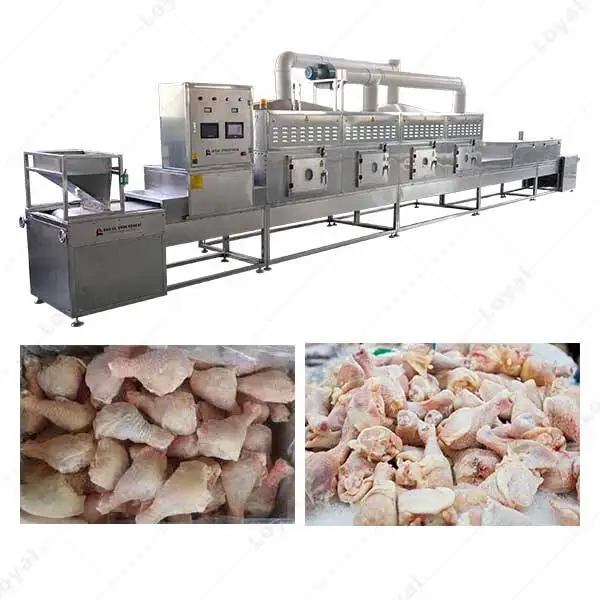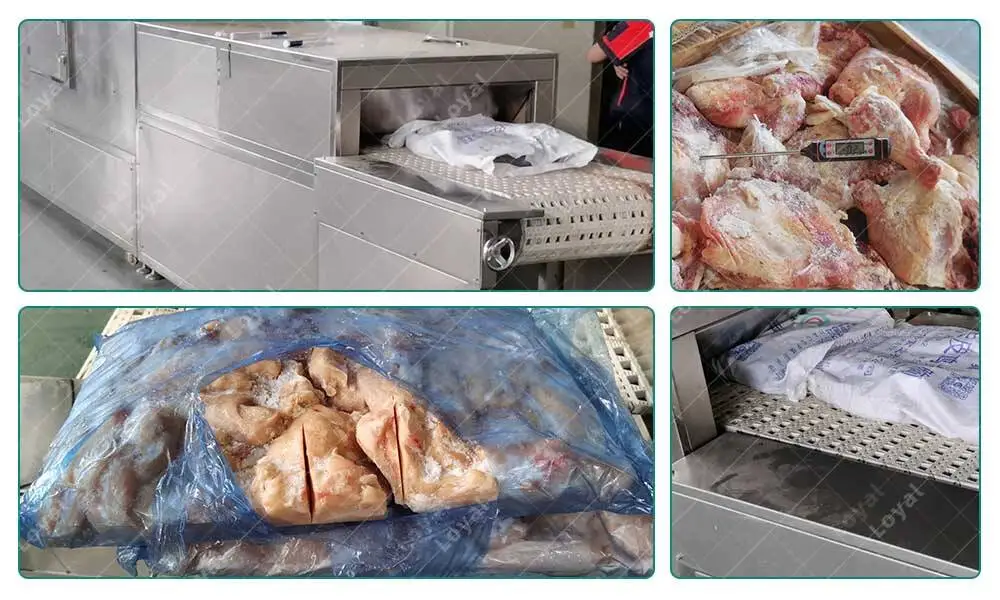What is an Accepted Technique for Thawing Frozen Food?
Thawing frozen food correctly is essential for both safety and quality. The process of thawing plays a crucial role in preventing the growth of harmful bacteria that can thrive on food as it transitions from frozen to room temperature. Understanding the best practices for thawing is thus critical for anyone handling food, from commercial kitchens to home cooks.
There are several common methods for thawing frozen foods, each with its own set of advantages and guidelines. These include the use of microwave thawing, refrigerator thawing, and cold water thawing. As we delve deeper into these techniques, special attention will be given to microwave thawing due to its speed and convenience, which make it a popular choice among many. However, despite its benefits, it is important to understand the proper procedures to ensure food is thawed safely and effectively.
Dr. Elizabeth Thompson, a food safety expert, emphasizes the importance of proper thawing techniques: "Incorrect thawing can lead to food safety issues that could be harmful to consumers. Each thawing method needs to be executed with care to maintain the integrity and safety of the food."
This introduction sets the stage for a more detailed exploration of these methods, particularly focusing on how to leverage modern technology, such as industrial defrosting equipment and microwaves, to safely reduce thawing times without compromising food quality.

Microwave Thawing: A Popular and Efficient Method
Microwave thawing stands out as a favored technique due to its speed and ease, making it particularly useful in settings where time is of the essence. Here’s a closer look at how microwave thawing works and the advantages it offers, along with crucial safety tips to ensure food is thawed safely.
Definition and Process
Microwave thawing involves using microwave radiation to rapidly raise the temperature of frozen foods, causing ice within the food to melt. Unlike slow thawing in a refrigerator, microwave thawing can defrost items in a matter of minutes. This method leverages the microwave’s ability to penetrate food and excite water molecules, thereby generating heat that thaws the food quickly.
Advantages
- Speed: Microwave thawing is significantly faster than other methods, reducing thawing time from hours to minutes, which can be crucial in a busy kitchen or when unexpected meal preparations arise.
- Convenience: It’s straightforward—most microwaves come with a ‘defrost’ setting, which adjusts the power level to suit thawing over cooking, making it accessible to everyone, including home cooks and professional chefs.
Safety Tips
To thaw food safely in a microwave, it’s important to follow these guidelines:
- Power Levels: Always use the defrost or 50% power setting to ensure that the outside of the food doesn't start cooking while the inside remains frozen.
- Uniform Thawing: To promote even thawing, pause halfway through the thawing process to check the food and, if necessary, separate pieces that are stuck together or rearrange them within the microwave.
- Microwave-Safe Containers: Use only containers and wraps that are designated as microwave-safe to avoid the risk of chemical contamination or melting plastic.
- Immediate Cooking: Once food is thawed in the microwave, it should be cooked immediately. The rapid temperature change can bring parts of the food into the "danger zone" (between 40°F and 140°F), where bacteria grow most rapidly.
Expert Commentary Chef Michael Harris, a culinary instructor, advises, "While microwave thawing can be a timesaver, it’s imperative to move quickly to cooking once thawing is complete. This method can unevenly heat food, creating warm spots where bacteria can thrive."
By adhering to these practices, microwave thawing can be a safe, efficient option for defrosting food quickly. Understanding the method’s advantages and following the recommended safety procedures will ensure that the food not only tastes good but is also safe to eat.
Comparing Microwave Thawing with Other Methods
To determine the most appropriate thawing method for various situations, it’s useful to compare microwave thawing with other common techniques. Each method has its own set of advantages and drawbacks, and understanding these can help in making informed decisions about which to use based on the specific needs of the food and the meal preparation.
Refrigerator Thawing
- Description: This involves placing frozen food in the refrigerator and allowing it to thaw slowly, typically over several hours or overnight.
- Time Requirements: Thawing in the refrigerator is the slowest method, often requiring planning a day ahead.
- Safety: Considered the safest method as it keeps food out of the "danger zone" (between 40°F and 140°F), reducing the risk of bacterial growth.
Cold Water Thawing
- Process: Involves submerging food in cold water, changing the water every 30 minutes to ensure it remains cold.
- Efficiency: Faster than refrigerator thawing, usually taking a few hours depending on the size of the food item.
- Considerations: Requires more attention to maintain safe water temperatures and needs a waterproof package to protect food.
Direct Cooking
- Explanation: Some foods can be cooked directly from frozen, effectively bypassing a separate thawing step.
- Applicability: Especially useful for items like frozen vegetables and smaller cuts of meat or fish.
- Drawbacks: May result in a longer cooking time and can affect the texture or uniformity of the cooked food.
Microwave Thawing
- Speed and Convenience: Microwave thawing is the fastest method, making it ideal for last-minute meal preparations.
- Drawbacks: Can lead to uneven thawing and may partially cook some areas of the food if not monitored closely.
Comparison: Pros and Cons
- Refrigerator Thawing: Best for safety and quality but requires significant forethought and time.
- Cold Water Thawing: Faster than refrigerator thawing, suitable for medium-sized food items, requires active management.
- Direct Cooking: Eliminates thawing time but can compromise cooking results.
- Microwave Thawing: Offers unmatched speed, best for rapid meal prep, but requires careful handling to avoid partial cooking.
Expert Insight Dr. Anne Miller, a food safety specialist, comments, "Choosing the right thawing method is crucial not just for food safety but also for preserving the quality of the food. While microwave thawing is excellent for speed, it’s important to use methods like refrigerator thawing whenever possible to maximize food quality and safety."
This comparative analysis underscores the importance of selecting a thawing method that not only meets the practical requirements of the kitchen but also aligns with food safety protocols. Each method has its place, and the choice often depends on the urgency of the meal preparation and the nature of the food being thawed.

Best Practices for Using Microwave Thawing
Microwave thawing is a valuable technique for quickly defrosting food, but it must be done correctly to ensure both safety and quality. Here’s a detailed guide on how to use microwave thawing effectively, including a step-by-step approach and tips to avoid common mistakes.
Step-by-Step Guide for Thawing Different Types of Food in the Microwave
Preparation:
- Remove any packaging that is not microwave-safe, such as plastic wraps or foam trays.
- Place the food in a microwave-safe dish to catch any drippings and prevent a mess inside the microwave.
Setting the Microwave:
- Use the 'defrost' or 'low power' setting to ensure gentle thawing. This helps prevent the outer edges of the food from cooking while the inside remains frozen.
- Adjust the time based on the weight of the food item, usually provided in the microwave’s manual or on defrost charts online.
Thawing Process:
- Turn or rotate the food halfway through the thawing process. If possible, flip the food to promote even thawing.
- For unevenly shaped items like chicken breasts or larger roasts, shield the thinner parts with small pieces of aluminum foil to prevent them from cooking.
Post-Thawing:
- Check the food immediately after thawing. If some parts are still frozen, return them to the microwave for additional defrosting.
- Cook the thawed food immediately to prevent any bacteria from developing.
Common Mistakes to Avoid
- Overthawing: Avoid setting the microwave for too long, which can start cooking the food, particularly the thinner edges or smaller pieces.
- Ignoring Manufacturer’s Instructions: Always follow the specific guidelines for your microwave model, as power levels and recommended times can vary significantly.
- Leaving Food Out After Thawing: Do not leave microwave-thawed food at room temperature. Cook it immediately to ensure it doesn't enter the bacterial "danger zone."
Expert Advice for Best Results
Culinary experts recommend using microwave thawing primarily for small to medium-sized items or portions. For example, Chef Olivia Martin suggests, "Microwave thawing is ideal for last-minute meal prep, especially for items like ground meat, chicken pieces, or vegetables that will be cooked immediately after thawing."
By following these best practices, microwave thawing can be a safe and efficient method to quickly bring frozen foods to a ready-to-cook state, maintaining food safety and quality. This approach ensures that even in a rush, the integrity and flavor of the food are preserved, contributing positively to the overall meal quality.
Conclusion
Throughout this guide, we have explored the various aspects of using microwave thawing as an efficient and popular method for defrosting frozen food. By understanding the process, advantages, and safety measures associated with microwave thawing, you can harness this technology effectively to enhance your meal preparation, ensuring both speed and safety.
Recap of Key Points Discussed
- Microwave Thawing Process: We've detailed how to use the microwave to thaw food quickly, emphasizing the importance of using low power settings and regular monitoring to prevent partial cooking.
- Advantages: The primary benefits of microwave thawing include its speed and convenience, which are particularly valuable in fast-paced environments or when unexpected meal prep needs arise.
- Safety Tips: Key guidelines such as using microwave-safe containers, adjusting power levels, and immediate cooking post-thawing help maintain food safety and quality.
Final Thoughts
Microwave thawing, when done correctly, is an excellent tool for modern kitchens, balancing efficiency with safety. It's ideal for last-minute thawing needs and smaller food items, making it an indispensable method in both home and professional settings. However, it's crucial to follow best practices to ensure that the food thaws evenly and remains safe to eat.
As we conclude, remember that the choice of thawing method should consider the type of food, the timing of your meal preparation, and the specific culinary outcomes you aim to achieve. While microwave thawing is perfect for quick defrosting, other methods like refrigerator thawing or cold water thawing might be more suitable for larger items or when texture and flavor retention are paramount.
Encouragement for Best Practices Embrace the technology available in your kitchen by using your microwave not just for cooking but as a strategic tool for thawing. With the right approach, you can maximize both the nutritional value and taste of your meals, ensuring that every dish is safe and delicious.
Thank you for exploring the nuances of microwave thawing with us. Whether you're a seasoned chef or a home cook, understanding and implementing these techniques will undoubtedly enhance your culinary practices. If you have any further questions or need more detailed information on specific aspects of microwave thawing, don't hesitate to reach out for more resources or professional advice.












